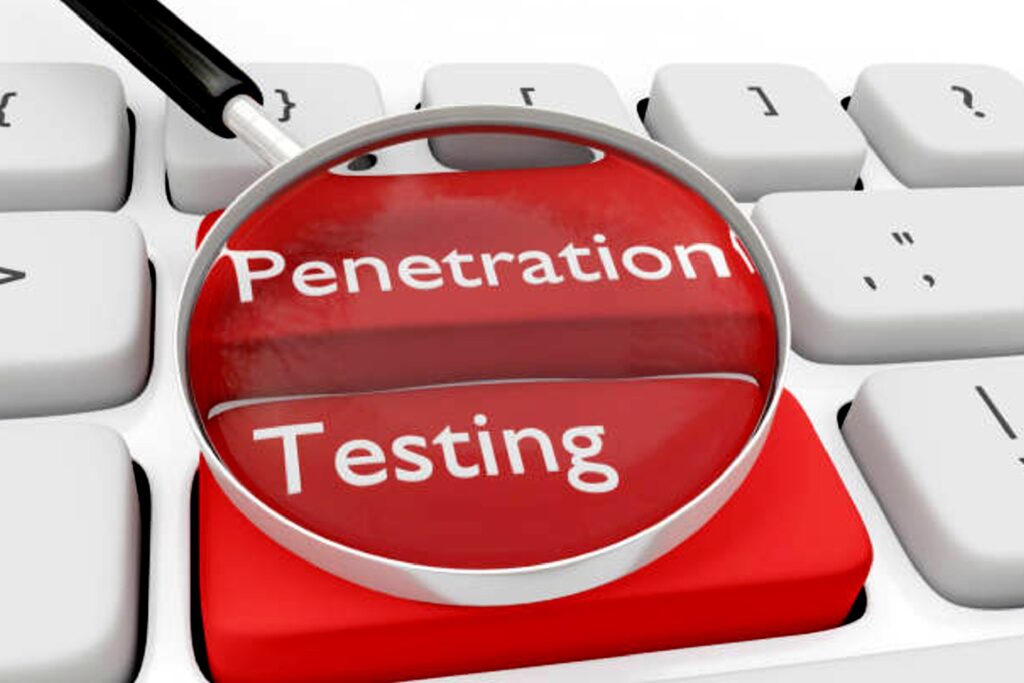Penetration Testing as a Service, PTaaS is a cloud-based service that provide resources to conduct a point-in-time cyber security tests. This test is also known as “pen testing,” and it simulates cyber attack on systems and networks.
It is used to test network defenses and identify vulnerabilities that an attacker could exploit. The goal of penetration testing is to assess the security of a system or application. In addition, provide recommendations for remediation and improving its defenses.
Penetration Testing as a Service is a a third-party company or individual that provides penetration testing services to organizations. They offer a varied testing services. This includes: web application, network, and wireless network penetration testing.
One benefit of using PTaaS is that, it allows you to outsource your penetration testing needs. It give free-hands to the experts who have the necessary skills, tools, and knowledge to do it. This can be very useful for smaller companies that may not have the resources in-house. Buying this expertise to conduct their penetration testing can also free up resources elsewhere.
PTaaS providers typically follow a set of industry standards and best practices when performing penetration tests. This includes adhering to ethical guidelines. For example, obtaining permission from the organization being tested, and not causing any damage to systems or data.
In addition, these providers do follow a defined process when conducting a penetration test. This process typically includes the following steps:
Planning and scoping
The PTaaS provider works with the organization to define the scope of the test, including which systems or applications will be tested and the types of attacks that will be simulated.
Penetration testing, also known as pen testing, is a valuable service that helps organizations identify vulnerabilities and weaknesses in their systems, networks, and applications. Pen testing can be a crucial part of an organization’s cybersecurity strategy, as it helps to identify and mitigate potential risks before they can be exploited by attackers.
When it comes to planning and scoping a pen testing engagement, there are several key considerations that organizations need to take into account. The first step in the process is to define the scope of the testing, which involves determining the specific systems, networks, and applications that will be tested. It’s important to have a clear understanding of what is and is not included in the scope of the testing, as this will help to ensure that the testing is focused and effective.
Once the scope of the testing has been defined, the next step is to determine the objectives of the testing. This involves identifying the specific vulnerabilities and weaknesses that the testing is intended to uncover. It’s important to be as specific as possible when defining the objectives, as this will help to ensure that the testing is focused and effective.
Once the scope and objectives of the testing have been defined, the next step is to determine the resources and tools that will be used to conduct the testing. This may include specialized software, hardware, and other resources that are necessary to effectively test the systems, networks, and applications in question. It’s also important to consider the skills and expertise of the team conducting the testing, as this will be a key factor in the success of the engagement.
Finally, it’s important to develop a thorough testing plan that outlines the specific steps that will be taken to conduct the testing. This may include steps such as reconnaissance, vulnerability assessment, and exploitation. The testing plan should be carefully reviewed and approved by all relevant stakeholders before testing begins.
Overall, the key to a successful pen testing engagement is careful planning and scoping. By clearly defining the scope and objectives of the testing, and carefully considering the resources and tools that will be used, organizations can ensure that their pen testing engagements are focused, effective, and provide valuable insights into the security of their systems, networks, and applications.
Reconnaissance
The PTaaS provider gathers information about the target system or application, including its architecture, technologies, and vulnerabilities.
Reconnaissance is an essential step in the process of conducting a successful penetration testing engagement. It involves gathering information about the systems, networks, and applications that are being tested, in order to identify potential vulnerabilities and weaknesses.
There are several different techniques that can be used to gather information during the reconnaissance phase of a pen testing engagement. These techniques may include:
- Network scanning: This involves using specialized tools to scan the network for open ports, services, and other information that may be useful to the tester.
- Social engineering: This involves attempting to gather information through human interaction, such as by tricking employees into revealing sensitive information.
- Website analysis: This involves analyzing a website for vulnerabilities and weaknesses, such as cross-site scripting (XSS) and SQL injection attacks.
- Physical reconnaissance: This involves gathering information about the physical layout of a facility, such as the location of servers, routers, and other equipment.
During the reconnaissance phase, it’s important to be as thorough as possible in gathering information. This will help to ensure that all potential vulnerabilities and weaknesses are identified and can be addressed during the testing process.
It’s also important to keep in mind that reconnaissance is an ongoing process that continues throughout the testing engagement. As the testing progresses and new information is gathered, the tester may need to revisit and update the initial reconnaissance efforts in order to ensure that all potential vulnerabilities and weaknesses are identified.
Overall, the key to successful reconnaissance during a penetration testing engagement is to be thorough and to continually update and refine the information that is gathered. By doing so, organizations can ensure that their pen testing engagements are effective and provide valuable insights into the security of their systems, networks, and applications.
Vulnerability assessment
The PTaaS provider uses a variety of tools and techniques to identify vulnerabilities in the target system or application.
Vulnerability assessment is an important step in the process of conducting a penetration testing engagement. It involves identifying and evaluating the vulnerabilities and weaknesses that were discovered during the reconnaissance phase of the testing.
There are several different techniques that can be used to conduct a vulnerability assessment during a pen testing engagement. These techniques may include:
- Scanning: This involves using specialized tools to scan the systems, networks, and applications being tested for vulnerabilities. These tools may include network scanners, web application scanners, and other types of scanners that are designed to identify specific types of vulnerabilities.
- Manual testing: This involves manually attempting to exploit vulnerabilities and weaknesses that have been identified during the reconnaissance phase. This may include attempting to access unauthorized areas of a network, or attempting to inject malicious code into a web application.
- Automated testing: This involves using automated tools to test for vulnerabilities and weaknesses. These tools may include web application scanners, network scanners, and other types of specialized software.
During the vulnerability assessment phase, it’s important to thoroughly evaluate all of the vulnerabilities and weaknesses that have been identified. This may involve prioritizing the vulnerabilities based on their potential impact and likelihood of being exploited, and developing a plan for addressing them.
Overall, the key to a successful vulnerability assessment during a penetration testing engagement is to be thorough and to carefully evaluate all of the vulnerabilities and weaknesses that have been identified. By doing so, organizations can ensure that their pen testing engagements provide valuable insights into the security of their systems, networks, and applications.
Exploitation
The PTaaS provider attempts to exploit vulnerabilities to gain access to the system or application.
Exploitation is the final step in the process of conducting a penetration testing engagement. It involves attempting to exploit the vulnerabilities and weaknesses that were identified during the reconnaissance and vulnerability assessment phases of the testing.
There are several different techniques that can be used to exploit vulnerabilities during a pen testing engagement. These techniques may include:
- Manual exploitation: This involves manually attempting to exploit vulnerabilities and weaknesses that have been identified. This may involve attempting to access unauthorized areas of a network, or attempting to inject malicious code into a web application.
- Automated exploitation: This involves using automated tools to exploit vulnerabilities and weaknesses. These tools may include web application scanners, network scanners, and other types of specialized software.
- Social engineering: This involves attempting to exploit vulnerabilities through human interaction, such as by tricking employees into revealing sensitive information or accessing restricted areas.
During the exploitation phase, it’s important to carefully document all of the vulnerabilities and weaknesses that have been successfully exploited. This will help to identify any potential risks and vulnerabilities that need to be addressed in order to secure the systems, networks, and applications being tested.
Overall, the key to successful exploitation during a penetration testing engagement is to be thorough and to carefully document all of the vulnerabilities and weaknesses that have been exploited. By doing so, organizations can ensure that their pen testing engagements provide valuable insights into the security of their systems, networks, and applications.
Post-exploitation
The PTaaS provider identifies any additional vulnerabilities or weaknesses that were uncovered during the exploitation phase.
Post-exploitation is the final phase of a penetration testing engagement, and involves reviewing and analyzing the results of the testing in order to identify any potential vulnerabilities or weaknesses that need to be addressed.
During the post-exploitation phase, the tester will typically review all of the information gathered during the testing, including any vulnerabilities and weaknesses that were successfully exploited. This may involve analyzing log files, reviewing network traffic, and examining the results of any automated testing tools that were used.
Based on this analysis, the tester will then identify any potential vulnerabilities or weaknesses that need to be addressed in order to secure the systems, networks, and applications being tested. This may involve recommending specific security measures or procedures, or providing guidance on how to remediate any identified vulnerabilities.
Once the post-exploitation phase is complete, the tester will typically prepare a detailed report outlining the findings of the testing and any recommendations for addressing identified vulnerabilities and weaknesses. This report should be reviewed by all relevant stakeholders in order to determine the best course of action for addressing any identified risks.
Overall, the key to successful post-exploitation during a penetration testing engagement is to carefully review and analyze the results of the testing in order to identify any potential vulnerabilities or weaknesses that need to be addressed. By doing so, organizations can ensure that their pen testing engagements provide valuable insights into the security of their systems, networks, and applications.
Reporting
The PTaaS provider prepares a report detailing the results of the test, including a list of identified vulnerabilities and recommendations for addressing them.
Reporting is an essential part of any penetration testing engagement, as it provides organizations with a detailed analysis of the results of the testing and any recommendations for addressing identified vulnerabilities and weaknesses.
There are several key components that should be included in a pen testing report. These may include:
- Executive summary: This should provide a high-level overview of the testing, including the scope and objectives of the testing, as well as any key findings and recommendations.
- Methodology: This should detail the specific techniques and tools that were used to conduct the testing, as well as the approach that was taken to identify and evaluate vulnerabilities and weaknesses.
- Findings: This should provide a detailed analysis of all of the vulnerabilities and weaknesses that were identified during the testing, including their potential impact and likelihood of being exploited.
- Recommendations: This should provide specific recommendations for addressing identified vulnerabilities and weaknesses, including any necessary remediation steps or security measures that should be implemented.
- Appendices: This may include any additional information or documentation that was collected during the testing, such as log files or network traffic analysis.
It’s important to note that the specific content and format of a pen testing report will vary depending on the needs and requirements of the organization. However, in general, a well-written report should provide a comprehensive overview of the testing, as well as specific recommendations for addressing identified vulnerabilities and weaknesses.
Overall, the key to a successful pen testing report is to provide a detailed analysis of the results of the testing and specific recommendations for addressing identified vulnerabilities and weaknesses. By doing so, organizations can ensure that their pen testing engagements provide valuable insights into the security of their systems, networks, and applications.
One key advantage of PTaaS is that it allows organizations to identify and address vulnerabilities before they can be exploited by malicious hackers. This can help organizations protect against cyber attacks and data breaches, which can have serious financial and reputational consequences.
PTaaS providers also often offer remediation services to help organizations fix vulnerabilities identified during a penetration test. This can include providing guidance on how to patch systems or applications, implementing additional security controls, or providing training to employees on how to better protect against cyber threats.
There are a few different types of PTaaS options available. These include: external penetration testing, internal penetration testing, and network penetration testing. In addition, web application penetration testing, and Wireless network testing.
External penetration testing
Penetration testing attempts to simulate an outside attack and help identify the vulnerabilities of a network. External penetration testing is performed from the outside and helps identify vulnerabilities in your external systems, networks, and applications. Testing your systems for vulnerabilities is an important part of staying safe online.
This test is designed to “attack” your system to see if it breaks down. It is an important part of your system’s resilience to attacks.
External pen testing typically involves testing the organization’s internet-facing assets, such as websites, web applications, and public-facing servers.
This testing typically involves several key steps, including reconnaissance, vulnerability assessment, exploitation, and post-exploitation. During the testing, a tester will use a variety of tools and techniques to identify vulnerabilities and weaknesses. The goal is to exploit them in order to determine the consequences.
Once testing is finished, the tester will lay out any findings and possible solutions to vulnerabilities. This report should be reviewed by all relevant stakeholders. The good thing is, it allows owners to determine the best course of action for addressing any identified risks.
There is so much more to pen testing than people realize. With it, you can suss out flaws and potential security issues in your organisation’s external-facing systems, networks and applications. Conducting regular external pen testing is the best way to protect against attacks on your system and networks. Once the vulnerabilities have been identified, they can be fixed and prepared for potential future breaches.
Internal penetration testing
Internal penetration testing simulates an attack from an internal source. For example, a disgruntled employee attempting to gain unauthorized access to a system.
This penetration testing, also known as internal pen testing. It is a type of cybersecurity service that helps you identify vulnerabilities within your internal systems, networks, and applications. It is designed to simulate the actions of an internal attacker. These are employees, contractors, or anyone in the organization’s overall cybersecurity strategy.
Internal pen testing examines the organization’s internal systems and networks for vulnerabilities. These are servers, workstations, and other devices that are connected to the internal network. The goal of testing is to identify any weakness that could be exploited. Having this knowledge of an internal attacker, can provide recommendations for addressing those vulnerabilities.
Internal pen testing typically involves several key steps, including reconnaissance, vulnerability assessment, exploitation, and post-exploitation. During the testing, the tester will use a variety of tools and techniques to identify vulnerabilities and weaknesses, and will attempt to exploit those vulnerabilities in order to determine the potential impact on the organization.
Once the testing is complete, the tester will typically prepare a detailed report outlining the findings of the testing and any recommendations for addressing identified vulnerabilities and weaknesses. This report should be reviewed by all relevant stakeholders in order to determine the best course of action for addressing any identified risks.
Overall, internal pen testing is an important service that helps organizations identify vulnerabilities and weaknesses in their internal systems, networks, and applications. By conducting regular internal pen testing, organizations can ensure that their systems and networks are secure and that they are well-prepared to defend against potential internal attacks.
Network penetration testing
Network penetration testing, also known as network pen testing, is a type of cybersecurity service that helps organizations identify vulnerabilities and weaknesses in their networks. This type of testing is designed to simulate the actions of an external or internal attacker, and is an important part of an organization’s overall cybersecurity strategy.
Network pen testing typically involves testing the organization’s internal and external networks, including servers, workstations, and other devices that are connected to the network. The goal of the testing is to identify any vulnerabilities or weaknesses that could be exploited by an attacker, and to provide recommendations for addressing those vulnerabilities.
Network pen testing typically involves several key steps, including reconnaissance, vulnerability assessment, exploitation, and post-exploitation. During the testing, the tester will use a variety of tools and techniques to identify vulnerabilities and weaknesses, and will attempt to exploit those vulnerabilities in order to determine the potential impact on the organization.
Once the testing is complete, the tester will typically prepare a detailed report outlining the findings of the testing and any recommendations for addressing identified vulnerabilities and weaknesses. This report should be reviewed by all relevant stakeholders in order to determine the best course of action for addressing any identified risks.
Overall, network pen testing is an important service that helps organizations identify vulnerabilities and weaknesses in their networks. By conducting regular network pen testing, organizations can ensure that their networks are secure and that they are well-prepared to defend against potential attacks.
Web application penetration testing
Web application penetration testing, also known as web app pen testing, is a type of cybersecurity service that helps organizations identify vulnerabilities and weaknesses in their web applications. This type of testing is designed to simulate the actions of an external attacker, and is an important part of an organization’s overall cybersecurity strategy.
Web app pen testing typically involves testing the organization’s web-based applications, such as websites, web portals, and other applications that are accessed via the internet. The goal of the testing is to identify any vulnerabilities or weaknesses that could be exploited by an attacker, and to provide recommendations for addressing those vulnerabilities.
Web app pen testing typically involves several key steps, including reconnaissance, vulnerability assessment, exploitation, and post-exploitation. During web application penetration testing, the tester will use a variety of tools and techniques to identify vulnerabilities and weaknesses. The goal is to exploit those vulnerabilities to determine the potential impact on the organization.
Once the testing is complete, the tester will typically prepare a detailed report outlining the findings of the testing and any recommendations for addressing identified vulnerabilities and weaknesses. This report should be reviewed by all relevant stakeholders in order to determine the best course of action for addressing any identified risks.
Overall, web app pen testing is an important service that helps organizations identify vulnerabilities and weaknesses in their web applications. By conducting regular web app pen testing, organizations can ensure that their web-based applications are secure and that they are well-prepared to defend against potential attacks.
Your Takeaway
Penetration testing is an ongoing security process that most companies embark upon in today’s business landscape. It is recommended that companies conduct penetration testing at least annually, or whenever there’s significant breach. Penetration testing as a service on the other hand, is a managed service for firms without dedicated pen testers. They still benefit from these services as those with in-house skilled pen testers. For examples, they Identify and mitigate potential vulnerabilities and weaknesses before they can be exploited. Like in-house staff, provides valuable insights into the security of systems, networks, and applications. They also help you meet regulatory and compliance requirements. In addition, they can help your company avoid costly data breaches and downtime. In all, they can help improve your overall security posture and reduce risk of future attacks.




